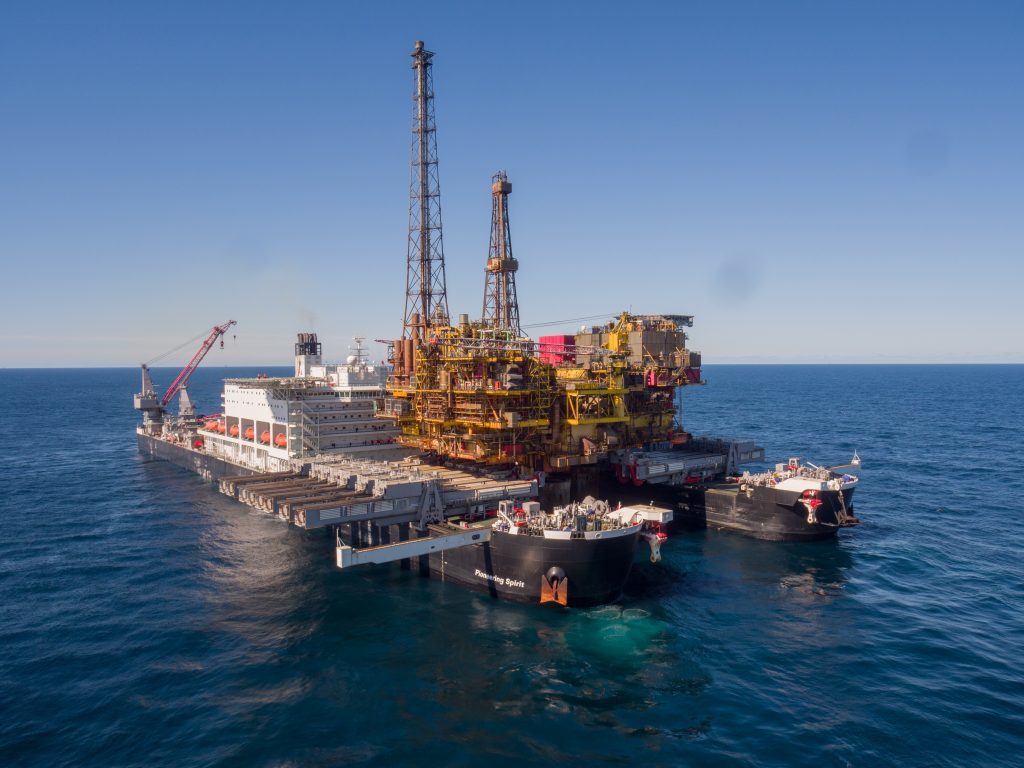
A few days ago, a behemoth of a ship graphically challenged and changed the way large production platforms in the North Sea and elsewhere will be decommissioned henceforth.
The ease with which the Allseas ship Pioneering Spirit gently uplifted the 24,200 tonnes Brent Delta platform topsides in one lump and shipped the enormous package to Teesside for dismantling by Able was also vindication of an approach to decommissioning that Allseas founder Edward Heerema began dreaming of at least 20 years ago.
Video: Pioneering Spirit completes Brent Delta topside lift for Shell
I think I first saw a concept model at the Offshore Technology Conference in Houston about 20 years ago.
Then, the idea was to buy a pair of trading oil tankers, strap them together to form a gigantic catamaran, fit it with motion compensated lifting beams and offer it as an alternative to at least partial dismantling of large platforms in-situ before removal to the beach for recycling.
In short, Edward Heerema wanted to transform decommissioning and, by combining the decommissioning function with another purpose … long-distance pipelay … it was hoped that a market-beater could be created.
I encountered the gigantic Pieter Schelte concept model at OTC, Offshore Europe and Offshore Northern Seas time and again across a string of years.
But then one day at whatever show it was, a very different model appeared on the Allseas stand. Gone were the tankers and in their place was a purpose-designed twin-hulled behemoth that would also be the world’s largest pipelayer.
The project was evolving … getting more purposeful and I began to wonder when an order would be placed. I never doubted that Allseas would build the vessel. It was a matter of timing.
In 2011, the button was pushed. DSME of South Korea won the contract to build a vast beast that would be capable of lifting topsides to 48,000 tonnes and jackets to 25,000 tonnes.
The Pieter Schelte, as it was still known would eclipse all other heavy lifters by a mile as indeed it has just demonstrated. It would represent Dutch maritime engineering on a grand-scale and be very expensive, not that Allseas has divulged the price tag.
Of course it hit problems along the way, with rumours especially about issues to do with the lifting beams. However, what matters is the ship was completed, not as the Pieter Schelte but as the Pioneering Spirit.
The original name was dropped following protests as Pieter Schelte after whom the project was initially named, was a Nazi sympathiser, etc, etc.
The ship cut its teeth on the Yme platform last summer … that was a snack. Everything worked, or at least seemed to be. The road was clear to lift the Brent Delta topsides as the opener of a contract awarded by Shell to lift and remove to shore, all four Brent topsides units.
And, on April 28, the lift of the Delta deck was successfully accomplished.
In my view, this really is a gamechanger for North Sea and global lmedium-to-large platform decom and I have gone on record by saying this on at least two occasions during the build phase of the Pioneering Spirit.
In December 2013, when Allseas revealed that it had decided to build a second single-lift platform installation and decommissioning vessel with lifting capacities 50% greater than the first, I wrote: “Between them these twin-hulled mega-ships will radically alter the decommissioning market in the North Sea.
“Indeed they will fundamentally change its shape as it should no longer be necessary to dismember the largest platform topsides offshore.
“Instead it will be possible to lift and ship ashore in one piece, even the biggest of all North Sea platform topsides in either the UK or Norwegian sectors.
“This should in turn greatly simplify offshore preparations of topsides, with all but the most essentially decontamination and disaggregation work carried out onshore in a decommissioning yard.
“Allseas’ decision to invest in a much larger vessel than the already game-changing Pieter Schelte should also simply the removal of even the largest.”
Heerema told an audience at Offshore Europe 2013 that he expected the sisters to be capable of uplifting a platform topsides (medium through large) per month in season, but that it would leave scope for other more “traditional” heavy lifters to secure decommissioning market share.
My view that the first Allseas behemoth would fundamentally change decom is echoed in a recent study by Douglas Westwood.
DW states that single-lift technology removes the need for demolition in place, creating significant savings – up to $7billion for the UKCS alone where the current decom estimate stands at around $50billion.
Let’s face it. This approach is safer, less messy; less dangerous too.
As I’ve said on numerous occasions, why wouldn’t any responsible operator be prepared to stand-in line … if needs be for a couple or three years … to get redundant platforms cleanly removed for demolition in the proper place … onshore.
I also believe there is at least one simpler, cheaper alternative to the hugely expensive Allseas approach, namely Craig Lang’s Nessie concept based on his original uber-simple MPSS semi-submersible design.
Look out for Nessie in June’s Energy.
Recommended for you
